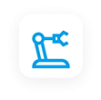Leveraging new technologies is improving efficiencies in logistics and supply chain automation industries. From increasing productivity to reducing production errors, the use of port and terminal sensors and warehouse robots is steadily increasing. These autonomous mobile robots (AMRs) are helping businesses adopt a digital edge.
Requiring little human intervention, AMRs vary in cost, size and level of artificial intelligence (AI). They can recognize their surroundings and use data to help with future decision making. Port and terminal sensors, for example, can help secure an industrial location, monitor other AMRs and prevent crane collisions. These new technologies are helping industrial businesses and warehouses meet demand.
Here’s how AMRs in warehouses contribute to the logistics/supply chain automation industries.
Increasing Warehouse and Industrial Resiliency
Given the uptick in the on-demand economy and ecommerce industries, the adoption of autonomous robots comes at the right time. It’s estimated that the market for logistics robots in warehouses will rise to $22.4 billion before 2022. Adopting robotic technologies ensures eCommerce supply chains and other industries can make deliveries and meet demand. From logistics and fulfillment centers to shippers and retailers and sorters, human warehouse labor is increasingly in short supply. And, there are various types of robots to fill the gap.
A few types of automated material handling equipment (warehouse and industrial robots) include:
- Autonomous Mobile Robots (AMRs)
- Visually Guided Vehicles (VGVs)
- Automated Guided Vehicles (AGVs)
- Automated Guided Carts (AGCs)
- Other types of robots include robotic pallet jacks, aerial drones and robotic carts
Meeting Demand with Automation Sensors
The concern with some warehouses and facilities is ways to integrate new technologies to help them scale. Robotic pallet movers are a prime example. They can carry significant loads of about 3,300-lbs each and the AMRs can work around the clock. With their increasingly apparent reliability, the deployment for warehouse robots isn't slowing down. If anything, they help ensure warehouses and other facilities can fully function.
The Rising Use of Sensors in Ports, Terminals and Warehouses
A LogisticsIQ report suggests that by 2025, AMR sales might increase to $27 billion. And the shift to add AMR technologies is coming at the right time. Ground transportation companies, warehouses and other facilities are seeing record demand. With the need for handlers, packers, sorters and pickers, autonomous robots are filling a void that’s driving record growth.
According to OSHA, about 97,000 forklift accidents occur every year. Workplace accidents can cause staffing shortages, product and vehicle damage and insurance premium increases. To avoid disruptions to workflows, facilities are using robots with advanced sensors to guide AMRs, AGVs, VGVs and AGCs. An additional incentive for adopting them is the unique sensors that guide them. These digital sensors can proactively do things like guide AMR traffic on a warehouse floor or prevent crane collisions at a seaport.
Sensors for Industrial Vehicles (AGVs)
Industrial vehicles (AGVs) operate using laser sensor technologies. Useful for transporting products in industrial settings, they're also cost-efficient. They work by batteries or electric power and can improve productivity by up to 70%.
AVGs help reduce workplace injuries and collisions on warehouse and factory floors. This is important in environments with hand trucks and forklifts.
A few examples include:
UAM-05LP
The UAM-05LP is a safety laser scanner. It's useful for monitoring robotic work cells, tracking the travel paths of autonomous vehicles and safeguarding personnel. It can travel on a designated path on the warehouse floor. It's a smaller scanner and a reliable solution to maximize safety.
Specs:
- It uses an Ethernet interface and works with a 270-degree field-of-view.
- With its 2D LiDAR (light detection and ranging) capabilities, it has a 5-meter safety zone with up to a 20-meter warning area.
- It uses obstacle detection and localization on AMRs, AGVs and carts.
UST-20LN
Able to detect obstacles to avoid accidents, the UST-20LN is a lightweight sensor. It's useful for measuring distances and detecting the presence of AGVs and AGCs.
Specs:
- This is a compact obstacle detection sensor and it has an RS422 and a USB interface.
- It includes a 270-degree field-of-view up to 20-meters.
- Easily programmable, it can trigger 3 area outputs with real-time detection.
Sensors for Overhead and Gantry Cranes
Another type of sensor is used with gantry and overhead cranes. It's estimated that from 2011-2015, there were 220 crane-related deaths. A single crane accident that kills one worker can cost just over $991,000 in hospital expenses. Overhead and gantry crane sensors can help avoid collisions and increase safety and workflows in industrial facilities.
Here are a few examples:
KAD-300
The KAD-300 is a crane collision sensor mountable for crane bridges. It can reduce collisions with monorail systems, overhead cranes, obstructions and fixed objects in a runway area. It's made with a durable metal housing for external use and it can initiate commands (warning, slow-down, stop).
Specs:
- This device includes 3 separate outputs for distance settings up to 100-feet.
- It includes a trouble (FAULT) output that energizes if a failure occurs with the internal emitter and receiver components.
- With limited hardware, it's easy to install and maintain and configurable for variable frequency drives and stepped controls.
UXM-30LN-PW
The UXM-30LN-PW is an obstacle detection sensor for outdoor use. It is used for area monitoring and presence detection applications. With an ON/OFF delay setting, it can ignore non-application related objects.
Specs:
- Equipped with a USB interface, it can obtain measurement data in a 190° field-of-view.
- It allows for 3 configurable area outputs up 30-meters.
- With an ON/OFF delay feature, it can ignore objects that move abruptly through zones (leaves blowing, debris, heavy dust).
- Users can create a close-range dead zone to filter out weather elements (rain, snow) in lens proximity.
Ports and Terminal Sensors
Having a reliable monitoring system can help ensure a seaport or terminal doesn’t have any crashes or other incidents. Hence, the use of smart technologies like port and terminal sensors can assist with tracking and maintaining operations. These sensors are reliable solutions to ensure the safety of container handling and include varying technological capabilities.
A few examples include:
UXM-30LXH-EWA
For optimal area scanning, the UXM-30LXH-EWA is a sensor for STS crane positioning. It can determine the location of trailers, AGVs and straddle carriers at ports and terminals. It’s used for outdoor-rated area monitoring applications. It can detect dark-colored objects and there's no effect on scanning performance caused by condensation or dust. It includes an integrated multi-echo feature for accurate measurement results in severe weather.
Specs:
- This is a 2D LiDAR sensor with 0.125° angular resolution.
- It's equipped with an Ethernet interface.
- It has a 190° field-of-view up to 80-meters.
UXM-30LAH-EHA
The UXM-30LAH-EHA is an outdoor-rated obstacle detection sensor. It's ideal for obstacle detection and localization on RTGs and crane booms, as well as pathway and cross travel collision prevention at ports and terminals.
Specs:
- It uses 2D LiDAR and includes reliable detection of dark-colored objects.
- Equipped with an Ethernet interface, it can obtain measurement data in a 190° field-of-view up to 80-meters.
- The 3 switching outputs allow for warning, slow-down and stop functions within defined area detection zones.
Smart Technologies that Increase Safety and Maximize Workflows
With new advances in digital technologies, the need for autonomy and technology is increasing. From autonomous mobile robots with AI to crane and pallet sensors, the digital age is helping warehouses and supply chain industries overcome unique challenges. While business needs vary, autonomous robots can improve supply chains, deliveries and logistics. Ultimately, meeting customer demand and increasing ROI are factors AMR can address.
Contact us to learn how warehouse and logistics sensors can improve your business.

 Factory Automation
Factory Automation Logistics Automation
Logistics Automation Process Automation
Process Automation Crane Collision Avoidance
Crane Collision Avoidance LiDAR/Obstacle Detection
LiDAR/Obstacle Detection Safety Laser Scanners
Safety Laser Scanners Optical Data Transmission
Optical Data Transmission Hot Metal Detectors
Hot Metal Detectors Laser Distance Sensor
Laser Distance Sensor Blog
Blog Whitepapers
Whitepapers Case Studies
Case Studies Infographics
Infographics